

For the parents to learn how to apply this method to make their parenting skills more effective, it is crucial to understand the differences and how to implement well. Reading: Reinforcement Theory. The basic premise of the theory of reinforcement is both simple and intuitive: An individual’s behavior is a function of the consequences of that behavior.
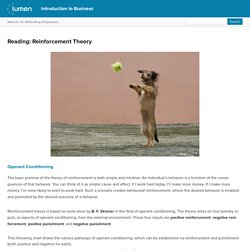
You can think of it as simple cause and effect. If I work hard today, I’ll make more money. If I make more money, I’m more likely to want to work hard. Such a scenario creates behavioral reinforcement, where the desired behavior is enabled and promoted by the desired outcome of a behavior. < Article Summary. The Big Bang Theory - Sheldon Trains Penny. < Video Explanation. Operant Conditioning - Negative Reinforcement vs Positive Punishment. < Video Explanation. Differences in a Table Form. Learning: Negative Reinforcement vs. Punishment. Reinforcement and Punishment. Learning Objectives Explain the difference between reinforcement and punishment (including positive and negative reinforcement and positive and negative punishment)Define shapingDifferentiate between primary and secondary reinforcers In discussing operant conditioning, we use several everyday words—positive, negative, reinforcement, and punishment—in a specialized manner.
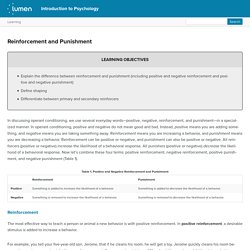
In operant conditioning, positive and negative do not mean good and bad. Instead, positive means you are adding something, and negative means you are taking something away. < Article Summary. 6 Positive Reinforcement Examples To Try With Your Kids. Positive reinforcement — using praise or rewards to shape your child's behavior — means "focusing on the 'good' things your children are doing or certain behaviors that you like and that you want to see more of," explains Melanie Rudnick, a New York City-based parenting expert and conscious parenting coach.
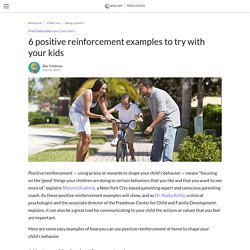
As these positive reinforcement examples will show, and as Dr. Nadja Reilly, a clinical psychologist and the associate director of the Freedman Center for Child and Family Development, explains, it can also be a great tool for communicating to your child the actions or values that you feel are important. Here are some easy examples of how you can use positive reinforcement at home to shape your child's behavior. < Article Summary. The Use of Reinforcement and Punishment in Shaping a Child's Behavior. < Video Explanation. Examples. How to Get Teenagers to Clean Up After Themselves. Living with a teenager may present a variety of challenges for parents.
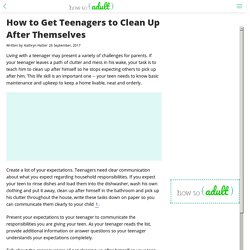
If your teenager leaves a path of clutter and mess in his wake, your task is to teach him to clean up after himself so he stops expecting others to pick up after him. This life skill is an important one -- your teen needs to know basic maintenance and upkeep to keep a home livable, neat and orderly. Create a list of your expectations. Teenagers need clear communication about what you expect regarding household responsibilities. If you expect your teen to rinse dishes and load them into the dishwasher, wash his own clothing and put it away, clean up after himself in the bathroom and pick up his clutter throughout the house, write these tasks down on paper so you can communicate them clearly to your child 1.
< Article Explanation. Negative Punishment Examples and Scenarios. Nobody ever wants their stuff taken away.
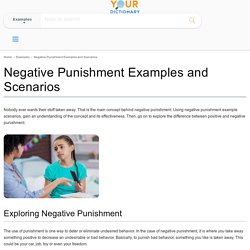
That is the main concept behind negative punishment. Using negative punishment example scenarios, gain an understanding of the concept and its effectiveness. < Article Explanation. Teenagers: 20 tips for good behaviour. 1.

Take time to actively listen Actively listening means paying close attention to what your child is saying and feeling, rather than thinking of what you want to say next. This shows your child that you care and that you’re interested. < Video Explanation.